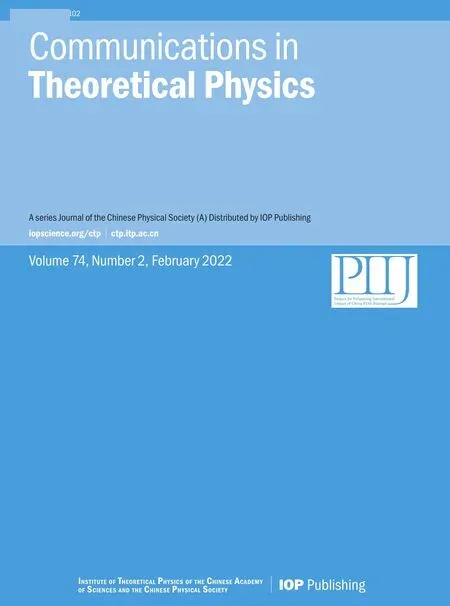Shape coexistence in 76Se within the neutron-proton interacting boson model
2022-03-12ChengFuMu穆成富andDaLiZhang张大立
Cheng-Fu Mu (穆成富) and Da-Li Zhang (张大立)
Department of physics, Huzhou University, Huzhou 313000, Zhejiang, China
Abstract
Keywords: shape coexistence, 76Se, E2 and M1 transitions, IBM-2
1.Introduction
In recent years, the shapes and shape evolution of selenium isotopes have been discussed in many works [1-6], in which the shapes of nuclei rapidly evolves from a prolate deformation around the line of β stability towards oblate deformation near the line of N=Z[7].The experimental results in[8] extended the yrast band of76Se from spin 12+at 5.429 MeV to 22+at 13.679 MeV and γ band from 10+at 4.685 MeV to 19+at 11.145 MeV, offering a chance for observation of the second band crossing.The theoretical and experimental results in[9-11]found that the triaxial degree of freedom plays an important role in76Se.Henderson et al extracted some electric quadrupole matrix elements and quadrupole moment ofstate which is consistent with a prolate deformation, but the ground state exhibits significant triaxiality [11].The dipole response of76Se in the energy interval from 4 to 9MeV has been discussed in terms of a polarized photon scattering technique [12].H T Fortune investigated the coexistence and mixing using a simple twostate mixing model in76Se [13].It is long believed that76Se nucleus can provide a platform to examine the shape coexistence.Shape phase transition and shape coexistence are a longstanding hot topic in nuclear physics[14-27].In the[28],Mukhopadhyay et al observed the band structure based on thestate at 1.122 MeV, the members of this band include thestate at 1.788 MeV andstate at 2.618 MeV, the experimental results support the shape coexistence in76Se.
Theoretical studies of selenium isotopes have been carried for a long time.U Kaup et al analyzed the band structure of selenium isotopes using the interacting boson model(IBM)[29].Budaca et al in [30] discussed the shape coexistence in Se isotopes in terms of a separable Bohr model using a double-well potential.K Nomura et al studied the structural evolution in selenium nuclei by means of the mapped IBM based on the Gogny energy density functional [2].In this paper,we extend our previous studies of IBM-2 on the shape coexistence to76Se nucleus [31-41], and extract the associated signatures of shape coexistence by analyzing the lowlying level scheme and M1 transition transition rates in addition to E2 transitons.We expect to improve the description ofstate in the framework of IBM-2 which is important for the shape coexistence.
The outline of this paper is listed as follows.In section 2,the IBM-2 Hamiltonian,as well as E2 and M1 operators used in this paper are briefly introduced.In section 3,we determine the model parameters, and compare our calculated results including E2 and M1 transitions with the experimental ones.The conclusion is presented in section 4.
2.Theoretical framework
In the original interaction boson model (IBM-1) proposed by Arima and Iachello,the collective properties of an even-even nucleus can be described by the coherent states of s bosons(angular momentum l=0)and d bosons(angular momentum l=2 ).Therefore, the IBM can be considered as one kind of truncation of shell model.The IBM-1 has U(6) symmetry group [42].By differentiating neutron bosons from proton bosons, the IBM-1 is extended to proton-neutron interacting boson model or IBM-2[43-47].The IBM-2 possesses a much richer phase structure and demonstrates a more predictive power in dealing with nuclear experimental data.In the IBM-2,the triaxial nuclear shape naturally occurs when the axes of a proton fluid with prolate deformation and a neutron fluid with oblate deformation are orthogonal to each other [48].Especially, the IBM-2 predicts a new class of collective state with mixed symmetry in protons and neutrons called mixedsymmetry (MS) states, for the detailed discussion refer to[49, 50].The other states are fully symmetric, generally known as FS states,which also can be equivalently described by IBM-1 [51].The IBM-2 Hamiltonian can include many interaction terms.In this paper,we adopt the following terms of Hamiltonian which gives the major contribution to76Se,more details are referred to in the following works[39,48-50,52],
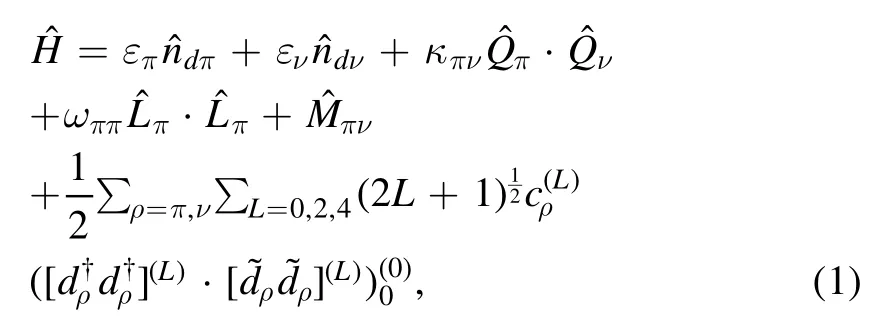

where the effective quadrupole charge eρand the gyromagnetic ratio gρare independent parameters and determined by fitting the experimental data.
Once one obtains the boson wave functions of a given nucleus, the reduced E2 and M1 electromagnetic transition probabilities can be easily computed through the quantum mechanics principle.The E2 transition strength B(E2)and M1 transition strength B(M1) are obtained by [38, 48, 52]

where J andJ′ are the initial and final spin angular momenta,respectively.The numerical calculation of energy spectrum and wave functions can be accomplished by using the computer code NPBOS [53].
3.Results and discussion
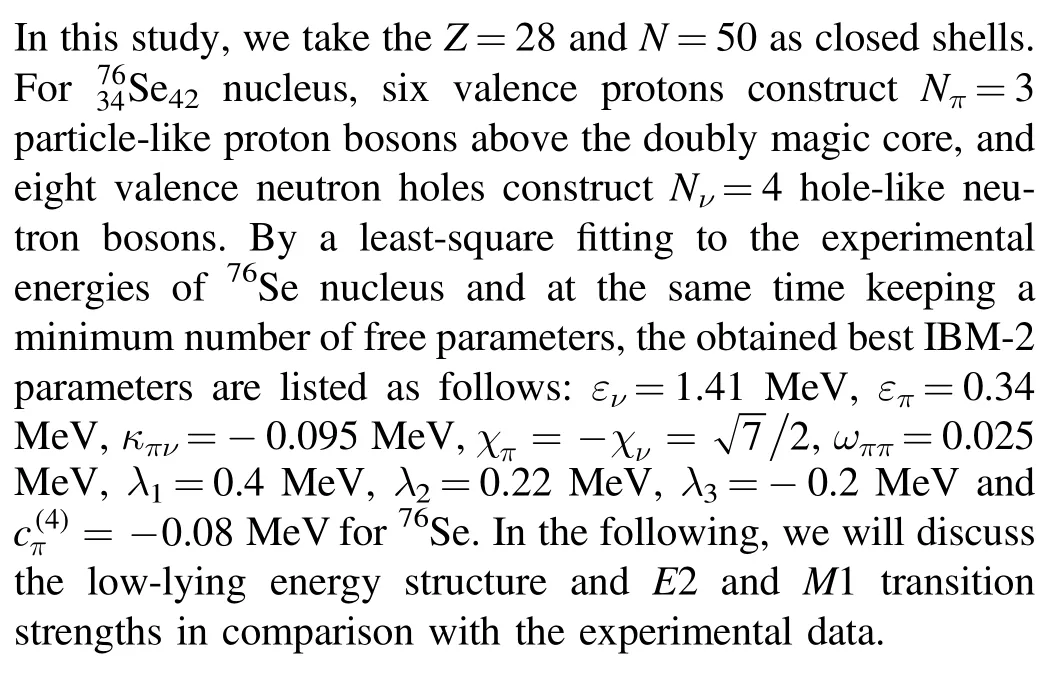
3.1.Energy levels
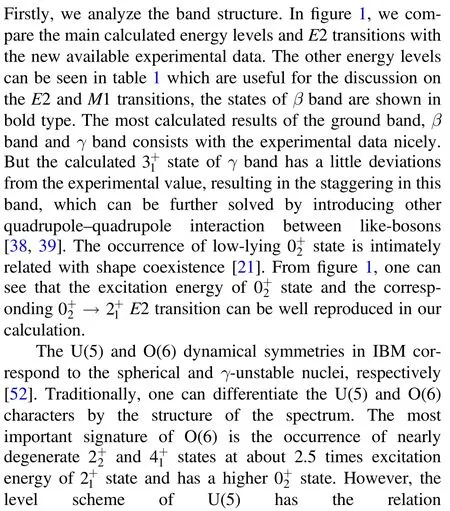
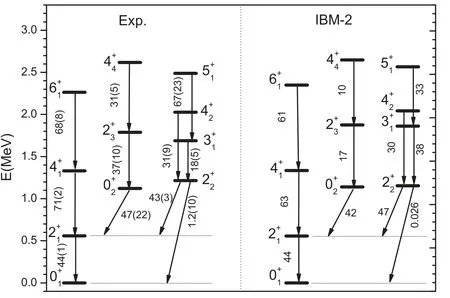
Figure 1.The calculated partial excitation energies (right panel) are compared with the experimental ones (left panel) for 76Se.The experimental data are taken from the [11, 28].
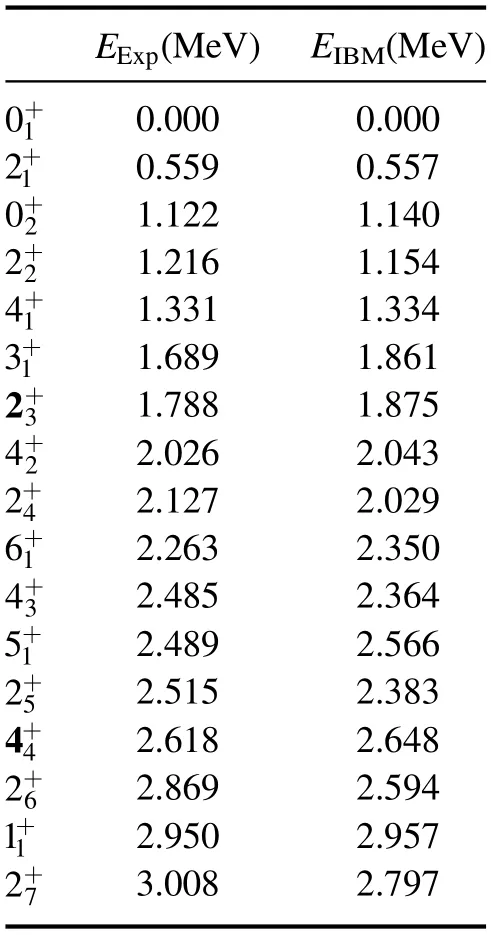
Table 1.The predicted levels are compared with the experimental results(taken from[11,28]).The states of β band are shown in bold type..

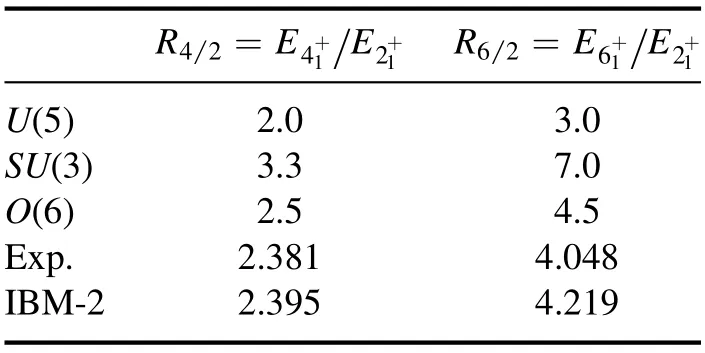
Table 2.The energy ratios R4/2 and R6/2 in the three dynamical limits are compared to the experimental and calculated values for 76Se.The three dynamical limits are taken from [30, 42].
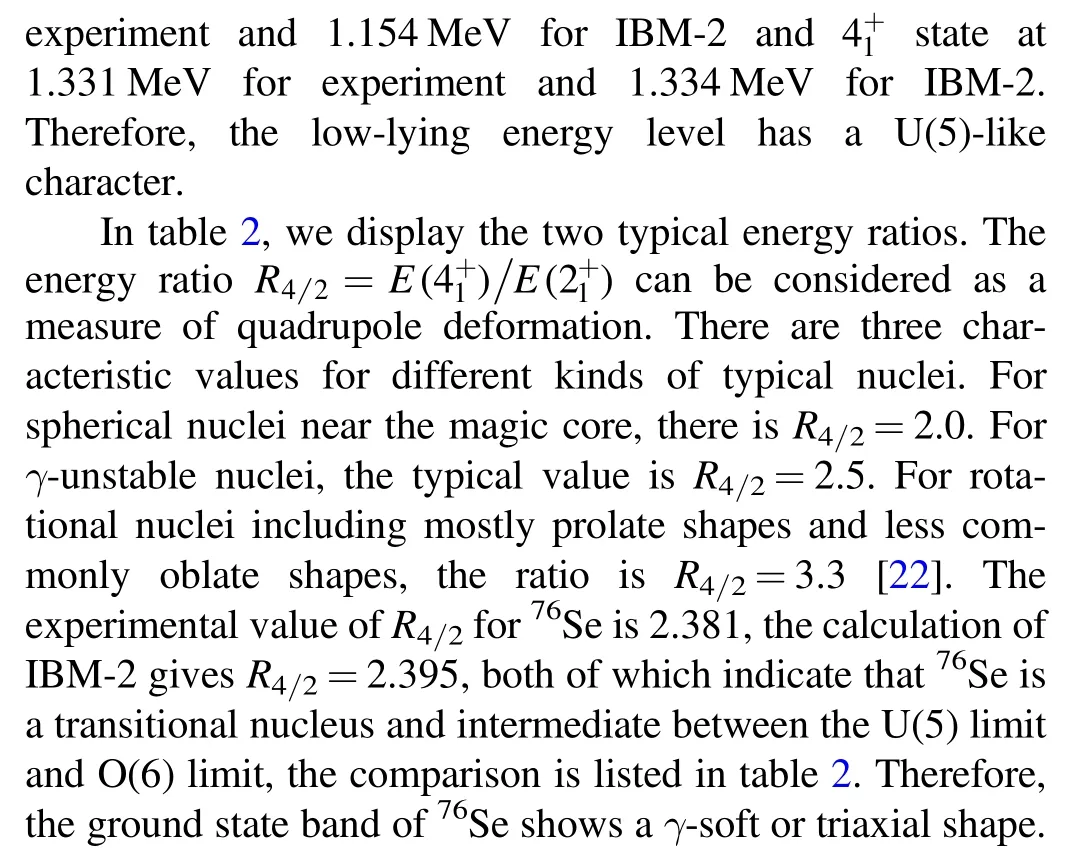

3.2.E2 transition
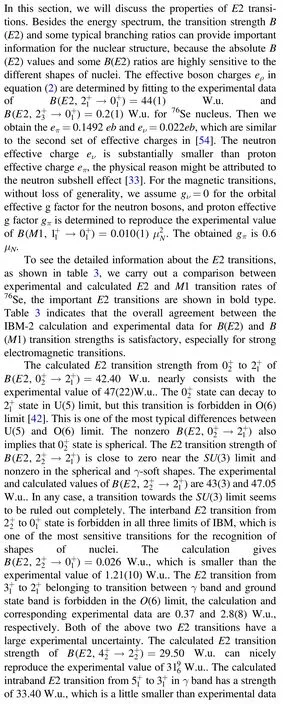

Table 3.Comparison between experimental and calculated E2 transition strengths(in W.u.)and M1 transition strengths(in for 76Se nucleus.The experimental data are taken from [11, 28].
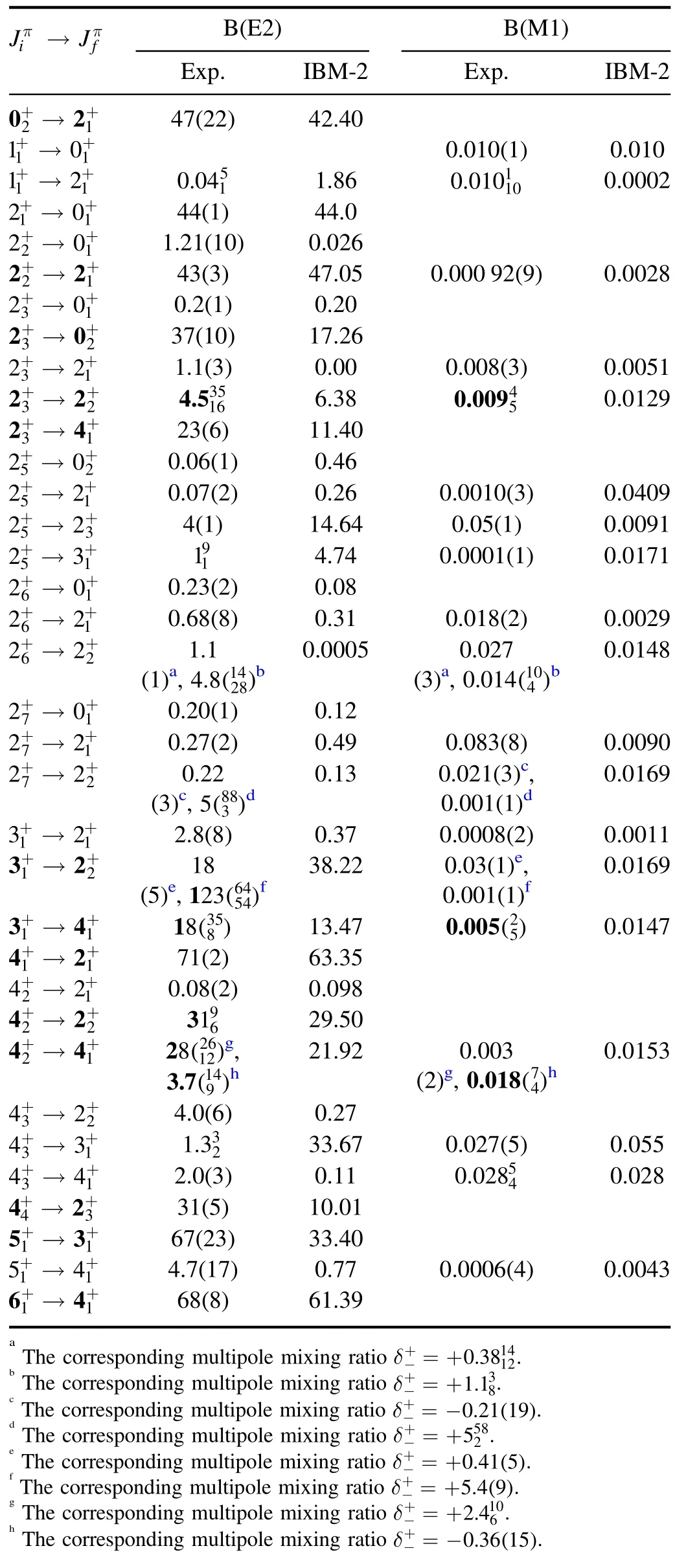
Table 3.Comparison between experimental and calculated E2 transition strengths(in W.u.)and M1 transition strengths(in for 76Se nucleus.The experimental data are taken from [11, 28].
?
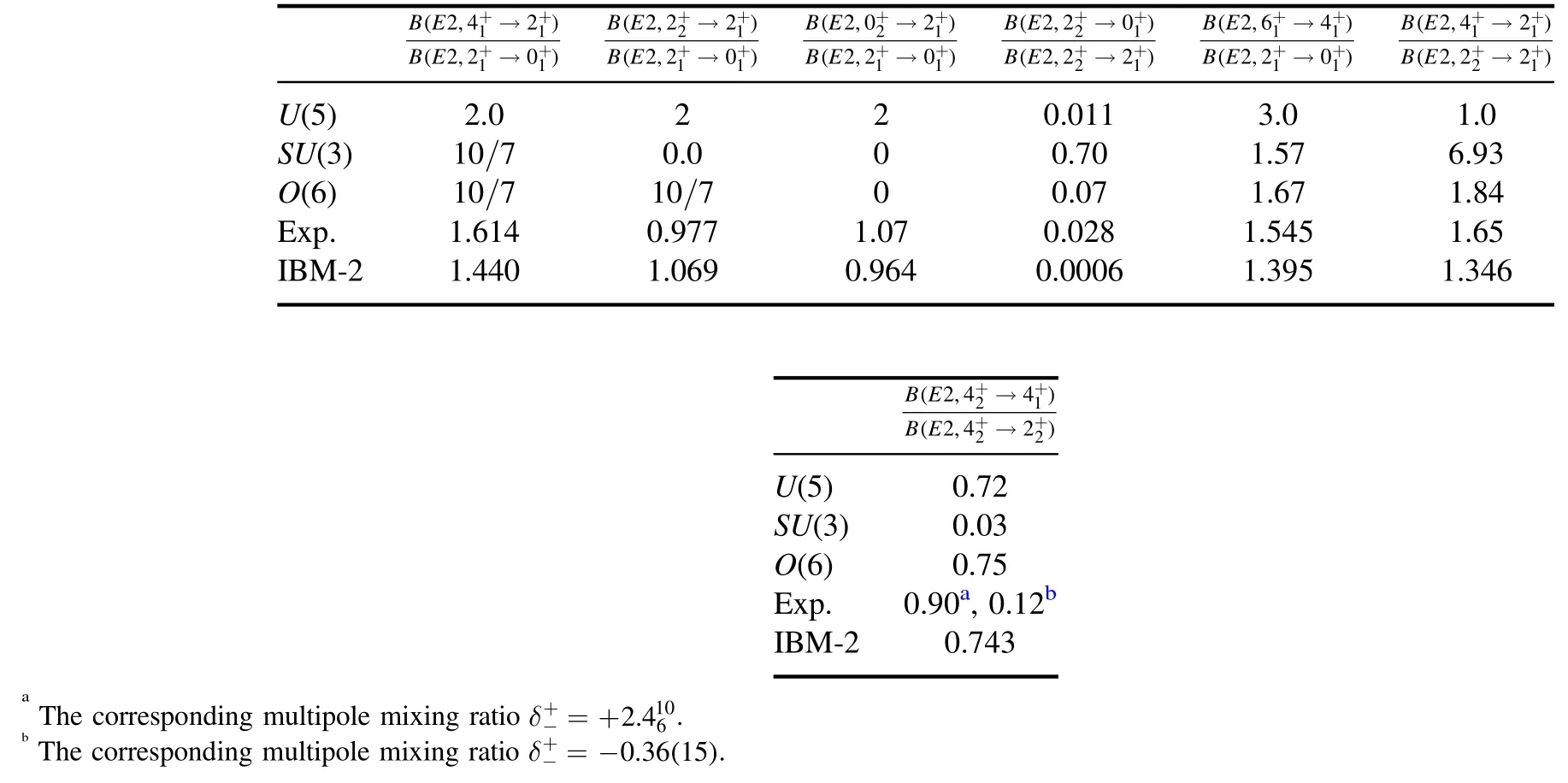
Table 4.Comparison of some B(E2)branching ratios in the three dynamical limits and the experimental and calculated values for 76Se.The values of three dynamical limits are taken from [33, 42, 46, 52, 55-57].

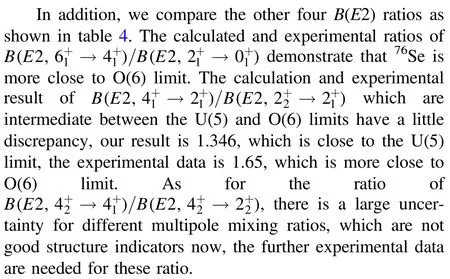
From the above discussion, both the experimental and theoretical results of the key sensitive quantities have confirmed that there is a coexistence between spherical and γ-soft shapes in76Se nucleus.Microscopically,similar to the Z=40 subshell effect on76Kr,the shape coexistence in76Se nucleus also might originate from effect of the N=40 subshell closure [58], the more analysis from the theoretical study is needed.
3.3.M1 transition.
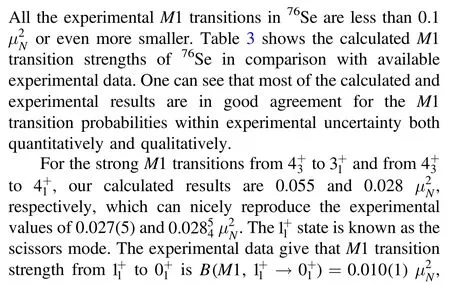
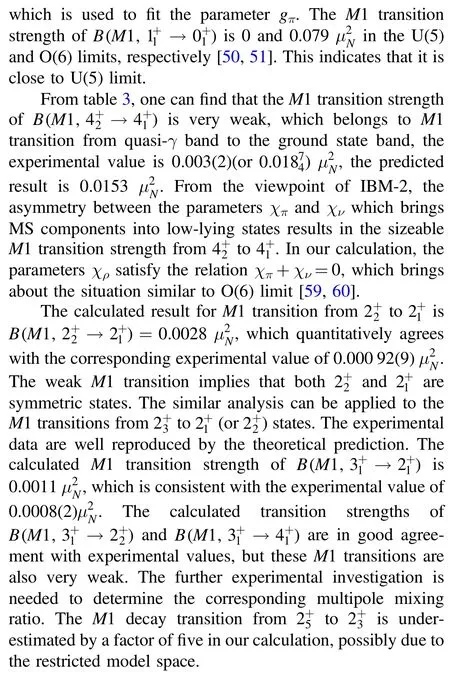
4.Conclusion
In summary, we have investigated the low-lying states and electromagnetic transitions in76Se in the framework of IBM-2.Our calculation can well reproduce the the properties ofstate,the calculated energy ratios R4/2and R6/2agree with the corresponding experimental data.We also calculate the several B(E2) branching ratios such as R1, R2, R3and R4, the calculations can nicely describe the experimental results.In the meantime,we compare the theoretical M1 transitions with the recent experiment.Based on the analysis on the energy energy ratios, the B(E2) branching ratios and M1 transitions,we can conclude that there is a coexistence between spherical shape and γ-soft shape in76Se.
Acknowledgments
The authors are grateful to Professor Y X Liu and Professor G L Long for helpful discussions.This work was supported by the National Natural Science Foundation of China under Grant Nos.12047568 and 11147148 and the Natural Science Foundation of Zhejiang Province under Grant No.LY19A050002.
猜你喜欢
杂志排行
Communications in Theoretical Physics的其它文章
- Influence of an indefinite causal order on an Otto heat engine
- Collapse arrest in a two-dimensional Airy Gaussian beam and Airy Gaussian vortex beam in nonlocal nonlinear media
- Comparison of thermodynamic behaviors of two regular-AdS black holes
- Quantum gravity effects on spectroscopy of Kerr-Newman black hole in gravity’s rainbow
- Radiative capture of proton by 9Be(p, γ)10B at low energy
- Decay properties of the X(3872) through the Fierz rearrangement
